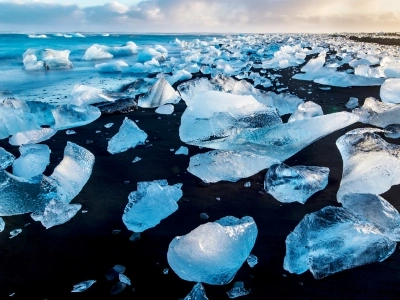Iceland, often called the “Land of Fire and Ice,” is a land of breathtaking contrasts. From its sprawling glaciers and volcanic landscapes to steaming geysers and serene waterfalls, the country offers awe-inspiring experiences year-round. But when is the best time to visit Iceland? The answer depends on what you want to see and do. Here, we break down Iceland’s seasons to help you plan the trip of a lifetime.
Winter in Iceland (November to February): The Northern Lights Season
Why Visit in Winter?
Winter in Iceland is magical. The long nights are perfect for witnessing the Northern Lights (Aurora Borealis). The snow-covered landscapes add an otherworldly charm, making it a dream for photographers and adventure seekers.
Activities in Winter
• Northern Lights Hunting: The dark skies provide the best opportunity to see this natural wonder.
• Glacier Hikes: Explore ice caves and hike across stunning glaciers like Vatnajökull.
• Hot Springs: Relax in geothermal pools such as the famous Blue Lagoon or the remote Reykjadalur valley.
• Winter Festivals: Experience unique events like the Iceland Airwaves Festival in Reykjavik.
Drawbacks of Visiting in Winter
• Limited daylight (4-6 hours) may restrict outdoor activities.
• Roads, especially in rural areas, can be icy and challenging to navigate.
Spring in Iceland (March to May): A Season of Renewal
Why Visit in Spring?
Spring marks the end of the harsh winter and the beginning of the thaw. The days grow longer, offering more time to explore. It’s also a quieter period, meaning fewer tourists.
Activities in Spring
• Waterfalls in Full Flow: Snowmelt enhances the power of waterfalls like Gullfoss and Skógafoss.
• Wildlife Watching: Puffins return to Iceland’s cliffs, and seals are commonly spotted.
• Spring Blooms: While Iceland isn’t known for lush flora, spring brings vibrant mosses and hardy flowers.
Drawbacks of Visiting in Spring
• The weather can be unpredictable, with a mix of rain, snow, and sunshine.
• Some highland roads may still be closed.
Summer in Iceland (June to August): The Midnight Sun and Outdoor Adventures
Why Visit in Summer?
Iceland’s summer offers endless daylight thanks to the Midnight Sun, with up to 24 hours of sunlight. It’s the ideal season for outdoor activities and exploring the country’s vast landscapes.
Activities in Summer
• Road Trips: Drive the Ring Road to see iconic sites like Jökulsárlón Glacier Lagoon and Reynisfjara Black Sand Beach.
• Hiking: Explore trails in Landmannalaugar or the Westfjords.
• Whale Watching: Spot humpback whales, minke whales, and even orcas.
• Cultural Events: Attend the Reykjavik Arts Festival or local village celebrations.
Drawbacks of Visiting in Summer
• Iceland is at its busiest, so expect higher prices and crowded attractions.
• Accommodation must be booked well in advance.
Autumn in Iceland (September to October): A Season of Change
Why Visit in Autumn?
Autumn is a shoulder season, offering a balance between summer’s warmth and winter’s chill. The landscapes are painted in hues of red, orange, and gold, making it a photographer’s paradise.
Activities in Autumn
• Northern Lights: With longer nights, the Aurora Borealis makes a comeback.
• Harvest Festivals: Experience Icelandic traditions like the Réttir Sheep Round-Up.
• Cultural Exploration: Fewer crowds mean more time to delve into Iceland’s history and culture.
Drawbacks of Visiting in Autumn
• Weather can be unpredictable.
• Daylight hours start to decrease significantly by late October.
Factors to Consider When Planning Your Trip
Weather in Iceland
Iceland’s weather is famously unpredictable. It’s often said you can experience all four seasons in one day. Dressing in layers and being prepared for sudden changes is crucial.
Daylight Hours
• Winter: 4-6 hours of daylight.
• Summer: Nearly 24 hours of daylight.
• Spring/Autumn: A gradual increase or decrease in daylight hours.
Crowds and Costs
• Peak Season (June-August): Expect higher prices and more tourists.
• Off-Season (November-March): More affordable but with limited accessibility to some areas.
Road Conditions
• Winter: Icy and challenging; a 4×4 vehicle is often necessary.
• Summer: Easier to navigate, with all major roads open.
Special Events to Plan Around
• Iceland Airwaves Festival (November): A celebration of music in Reykjavik.
• Secret Solstice Festival (June): A music festival held during the Midnight Sun.
• Líf og List (August): Celebrates Icelandic culture, art, and food.
Conclusion
The best time to visit Iceland ultimately depends on your interests. If you dream of witnessing the Northern Lights and exploring icy landscapes, winter is your season. For endless daylight and outdoor adventures, summer is ideal. Spring and autumn offer a mix of experiences with fewer crowds.
No matter when you visit, Iceland’s natural beauty and unique culture promise an unforgettable journey. Plan well, dress appropriately, and let the land of fire and ice captivate you.


Comment (0)